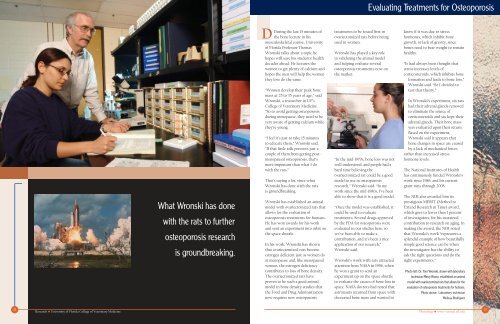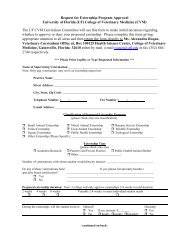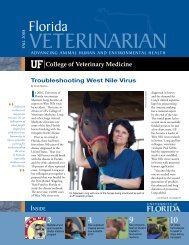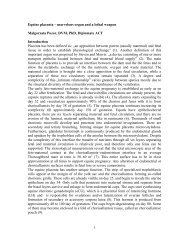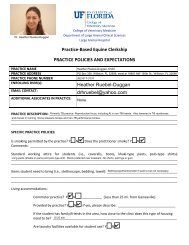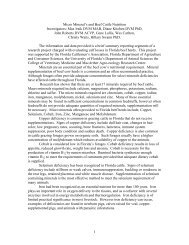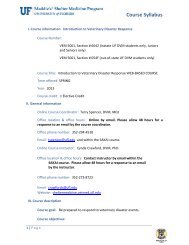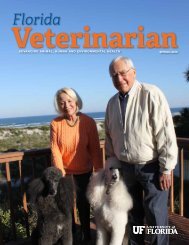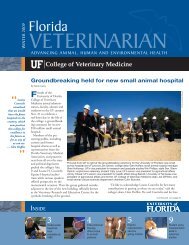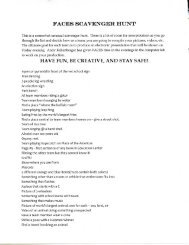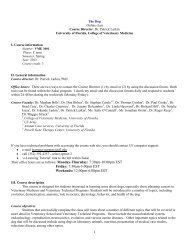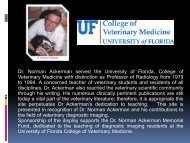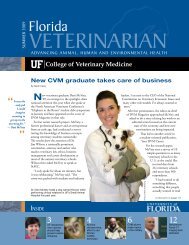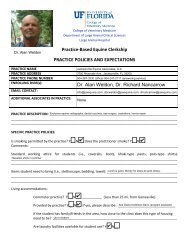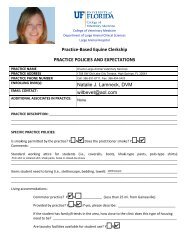Focusing on Breathing Awareness and DiseasePhoto top: Dr. Paul Davenport, shown in his lab with graduate student SarahPeiying Chan, is one <strong>of</strong> the few researchers in the college working on bothhumans and animals. Photo below demonstrates the use <strong>of</strong> a breathing device.IIt’s a common description,that something is as naturalas breathing.But for some children with severeasthma, breathing isn’t natural at all.In fact, these children can’t sensewhen they struggle with breathingand <strong>of</strong>ten end up in the emergencyroom on the verge <strong>of</strong> respiratoryfailure, said University <strong>of</strong> FloridaPr<strong>of</strong>essor Paul Davenport.For years, Davenport has beenstudying something most peopletake for granted: How youconsciously know you are breathing.For healthy people, it seemsautomatic, but the brain is still atwork, regulating respiration. Forsome asthmatic children, thosesignals from the brain are faulty.“If a patient can’t sense a problemwith their breathing, they can’tcompensate for it,” said Davenport, apr<strong>of</strong>essor in UF’s <strong>College</strong> <strong>of</strong><strong>Veterinary</strong> <strong>Medicine</strong> since 1981.So Davenport and colleagues in theUF <strong>College</strong> <strong>of</strong> <strong>Medicine</strong> developedthe Respiratory Related EvokedPotential test in 1986. During thetest, a patient’s breathing isincreasingly impeded with amechanical device as scientistsmeasure brain wave activity andbreathing responses. The test helpsidentify children who lack theability to sense difficulty breathing,so they can be monitored and avoida life-threatening asthma attack.Asthma is the top chronic disease<strong>of</strong> childhood, and 60 percent <strong>of</strong> thechildren who have life-threateningasthma have a reduced ability totell the difference between a mildobstruction to their breathing and asevere obstruction, Davenport said.People who have had a double lungtransplant or spinal cord injuriesalso have trouble sensing difficultieswith their breathing.“For most people, if you stopbreathing for 2/10 <strong>of</strong> a second, itelicits a reaction,” Davenport said.“Most people can feel a chesttightness and treat themselves.”The reverse issue - patients who aretoo aware <strong>of</strong> their breathing, whichleads to anxiety and overuse <strong>of</strong>medication – also is a topic <strong>of</strong>research for Davenport.“One group can’t perceive breathingproblems, the other group ishyperperceptive about breathingproblems,” Davenport said. “So wewant to understand the physiology <strong>of</strong>breathing. If you can’t breathe,nothing else matters.”In the hyperperceptive group <strong>of</strong> asthmapatients, the anticipation <strong>of</strong> a futurebreathing problem leads to anxiety. Ineffect, they prompt a respiratory eventwith their anxiety and panic and end uprelying heavily on medication.“If you can’tbreathe,nothing elsematters.”Dr. Paul Davenport“Nothing bothers you more than thesense <strong>of</strong> suffocation,” Davenport said.“So these patients end up reaching fortheir inhaler at the slightest sign <strong>of</strong>tightening in their chests and end uptaking in more medication than theyneed to regulate their asthma.“We’re wandering into a brand newarea,” Davenport said.Davenport also has explored ways tostrengthen respiratory muscles andhas invented a device that amounts toa barbell for the lungs. The device canbe used for healthy people, like tubaplayers in a high school marchingband, and by people who havesuffered a loss <strong>of</strong> respiratory capacity,such as people on ventilators orvictims <strong>of</strong> spinal cord injuries. In fact,Davenport worked with actorChristopher Reeve and U.S. Navydivers in testing the device.One advantage <strong>of</strong> the device is thatit does not involve a drug; it’smechanical, so it can be used by justabout anyone.“We need to change the way welook at ventilation,” Davenport said.“We don’t want to just make apatient comfortable on abreathing machine, we want torehab because it is possible to dorespiratory rehabilitation.”Patients on ventilators have beenanesthetized and immobilizedand lose some <strong>of</strong> their respiratorycapacity. That leads to fear whenit’s time for them to breathe ontheir own. But with therapy tostrengthen their respiratorymuscles, 90 percent <strong>of</strong> thepatients who initially fail to weanfrom a breathing machine cancome <strong>of</strong>f ventilation.Although he’s a physiologist, nota veterinarian, Davenport is one<strong>of</strong> the few researchers in thecollege working on both humansand animals.“There are some questions wecan only address in humans andsome questions we can onlyaddress in animals,” Davenport said.“We can’t answer all the questionsin one species.”In addition to his research grantsfrom the National Institutes <strong>of</strong>Health and the American LungAssociation, Davenport also has wonthe Merck National Creativity inTeaching Award. He used the$25,000 grant to fund seminars oncreative teaching strategies.26<strong>Research</strong> • University <strong>of</strong> Florida <strong>College</strong> <strong>of</strong> <strong>Veterinary</strong> <strong>Medicine</strong>••Physiology • www.vetmed.ufl.edu27
Evaluating Treatments for OsteoporosisWhat Wronski has donewith the rats to furtherosteoporosis researchis groundbreaking.DDuring the last 15 minutes <strong>of</strong>the bone lecture in hismusculoskeletal course, University<strong>of</strong> Florida Pr<strong>of</strong>essor ThomasWronski talks about a topic hehopes will save his students’ healthdecades ahead. He lectures thewomen to get plenty <strong>of</strong> calcium andhopes the men will help the womenthey love do the same.“Women develop their peak bonemass at 25 to 35 years <strong>of</strong> age,” saidWronski, a researcher in UF’s<strong>College</strong> <strong>of</strong> <strong>Veterinary</strong> <strong>Medicine</strong>.“So to avoid getting osteoporosisduring menopause, they need to bevery aware <strong>of</strong> getting calcium whilethey’re young.“I feel it’s just to take 15 minutesto educate them,” Wronski said.“If that little talk prevents just acouple <strong>of</strong> them from getting postmenopausalosteoporosis, that’smore important than what I dowith the rats.”That’s saying a lot, since whatWronski has done with the ratsis groundbreaking.Wronski has established an animalmodel with ovariectomized rats thatallows for the evaluation <strong>of</strong>osteoporosis treatments for humans.He has won awards for his workand sent an experiment into orbit onthe space shuttle.In his work, Wronski has shownthat ovariectomized rats becomeestrogen deficient just as women doat menopause and, like menopausalwomen, the estrogen deficiencycontributes to loss <strong>of</strong> bone density.The ovariectomized rats haveproven to be such a good animalmodel in bone density studies thatthe Food and Drug Administrationnow requires new osteoporosistreatments to be tested first inovariectomized rats before beingused in women.Wronski has played a key rolein validating the animal modeland helping evaluate severalosteoporosis treatments now onthe market.“In the mid-1970s, bone loss was notwell understood, and people had ahard time believing theovariectomized rat could be a goodmodel to use in osteoporosisresearch,” Wronski said. “In mywork since the mid-1980s, I’ve beenable to show that it is a good model.“Once the model was established, itcould be used to evaluatetreatments. Several drugs approvedby the FDA for osteoporosis wereevaluated in our studies here, sowe’ve been able to make acontribution, and it’s been a niceapplication <strong>of</strong> our research,”Wronski said.Wronski’s work with rats attractedattention from NASA in 1996, whenhe won a grant to send anexperiment up on the space shuttleto evaluate the causes <strong>of</strong> bone loss inspace. NASA doctors had noted thatastronauts returned from space withdecreased bone mass and wanted toknow if it was due to stresshormones, which inhibit bonegrowth, or lack <strong>of</strong> gravity, sincebones need to bear weight to remainhealthy.“It had always been thought thatstress increases levels <strong>of</strong>corticosteroids, which inhibits boneformation and leads to bone loss,”Wronski said. “So I decided totest that theory.”In Wronski’s experiment, six ratshad their adrenal glands removedto eliminate the source <strong>of</strong>corticosteroids and six kept theiradrenal glands. Their bone masswas evaluated upon their return.Based on the experiment,Wronski said it appears thatbone changes in space are causedby a lack <strong>of</strong> mechanical forcesrather than increased stresshormone levels.The National Institutes <strong>of</strong> Healthhas continuously funded Wronski’swork since 1986, and his currentgrant runs through 2008.The NIH also awarded him itsprestigious MERIT (Method toExtend <strong>Research</strong> in Time) award,which goes to fewer than 1 percent<strong>of</strong> investigators, for his sustainedcontribution to research on aging. Inmaking the award, the NIH notedthat Wronski’s work “represents asplendid example <strong>of</strong> how beautifullysimple good science can be whenthe investigator has the ability toask the right questions and do theright experiments.”Photo left: Dr. Tom Wronski, shown with laboratorytechnician Mercy Rivera, established an animalmodel with ovariectomized rats that allows for theevaluation <strong>of</strong> osteoporosis treatments for humans.Photo above: Laboratory technicianMelissa Rodriguez28<strong>Research</strong> • University <strong>of</strong> Florida <strong>College</strong> <strong>of</strong> <strong>Veterinary</strong> <strong>Medicine</strong>••Physiology • www.vetmed.ufl.edu29


